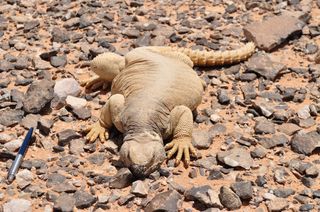
Medieval desert-dwelling Arabs in Saudi Arabia ate lizards after the advent of Islam, which generally prohibits eating reptiles, new research suggests.
Though historical and anthropological texts had mentioned the taste for these scaly desert snacks, the find is the first archaeological evidence confirming the lizard's presence in the Arabian diet, study co-author Hervé Monchot, a zooarchaeologist at the Université-Paris Sorbonne, wrote in an email to Live Science.
The lizards were probably eaten because they are "an excellent source of protein," Monchot said. [Arabian Desert: Aerial Photos of Mysterious Stone Structures]
Forbidden foods?
Just as Judaism has rules on what foods are kosher, Islam has its own laws about which foods are "halal" (or permissible) and "haram" (sinful or forbidden) to eat. In general, animals like snakes and lizards whose blood doesn't gush when chopped are considered haram.
Yet some of the informal sayings, or hadiths, of the Prophet Muhammad mention the nomadic Bedouin populations eating lizards just as the Islamic faith emerged: though Muhammad refused to eat the lizards himself, he didn't explicitly condemn the practice.
An 11th-century text by the Persian Nasir Khusraw, who traveled along ancient trade routes through the region, also noted, "That as soon as his fellow travellers caught sight of a lizard, they seized it, killed it and ate it," the authors write in their paper. And later European travelogues mention that lizards were slaughtered to make tobacco purses and to preserve butter, and were also occasionally eaten by the locals.
Sign up for the Live Science daily newsletter now
Get the world’s most fascinating discoveries delivered straight to your inbox.
Still, evidence of this habit remained scarce in archaeological remains.
Lizard snacks
Monchot and his colleagues were excavating an oasis site in the Saudi Arabian desert known as al-Yamâma, which has been occupied from the second century B.C. to the 1800s. The site, which was part of a large mosque complex, contained layers of food waste filled with camel and goat bones.
The bone dumps also contained 145 skeletal remains of a lizard, most likely the spiny-tailed lizard, Uromastyx aegyptia. The spiny-tailed lizard, which can grow to a length of about 2.2 feet (70 centimeters), is found throughout the desert regions of the Middle East. The bones were found in layers that spanned almost the entire period of human occupation there, and a cut mark on the leg bone of one lizard also indicated butchery.
The desert-dwelling people of the region may have been butchering and eating these animals in the same way for at least 2,000 years. Another recent study of nomadic people and oasis farmers in Oman, for instance, found they occasionally hunt lizards, which are easy to catch by digging them out of holes or trapping them with snares, the authors write. These nomads also cut the head and legs off first, which would create cut marks similar to those found in the archaeological remains.
Of course, that doesn't mean lizard eating is a widespread staple of the Arabian diet.
"It is necessary to distinguish the Bedouin, who ate and [still] eat lizard when traveling in the desert because it is a source of easy-to-find protein, and urban populations who do not eat lizard," Monchot said.
The findings were published online Feb. 26 in the Journal of Archaeological Science.
Follow Tia Ghose on Twitter and Google+. Follow Live Science @livescience, Facebook & Google+. Original article on Live Science.

Tia is the managing editor and was previously a senior writer for Live Science. Her work has appeared in Scientific American, Wired.com and other outlets. She holds a master's degree in bioengineering from the University of Washington, a graduate certificate in science writing from UC Santa Cruz and a bachelor's degree in mechanical engineering from the University of Texas at Austin. Tia was part of a team at the Milwaukee Journal Sentinel that published the Empty Cradles series on preterm births, which won multiple awards, including the 2012 Casey Medal for Meritorious Journalism.
Most Popular


